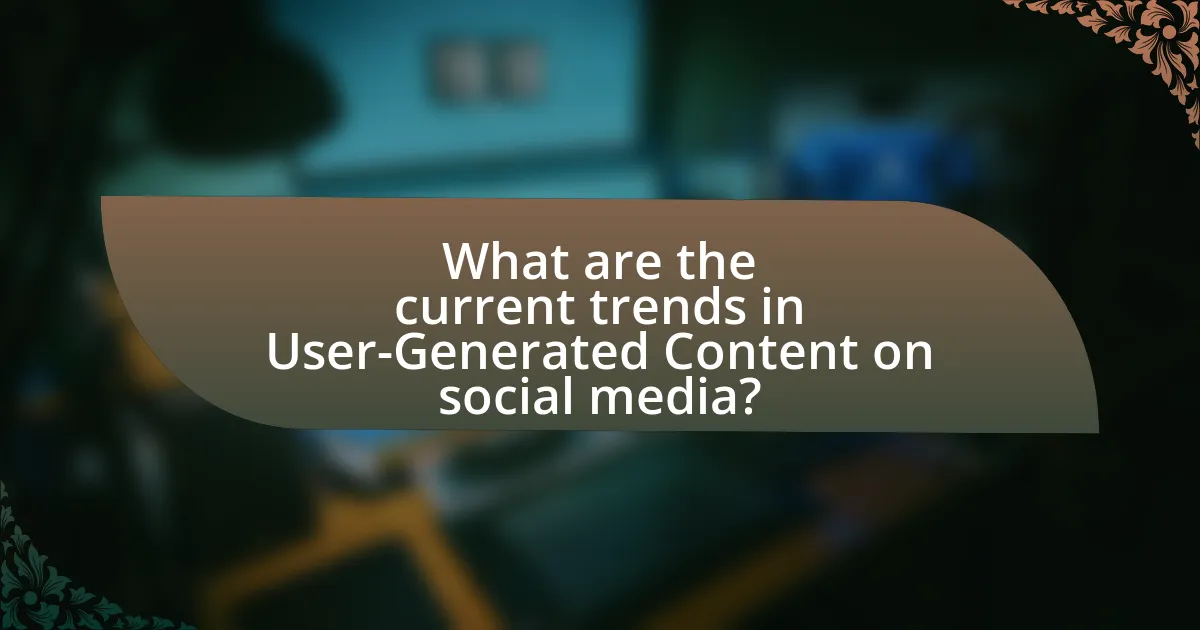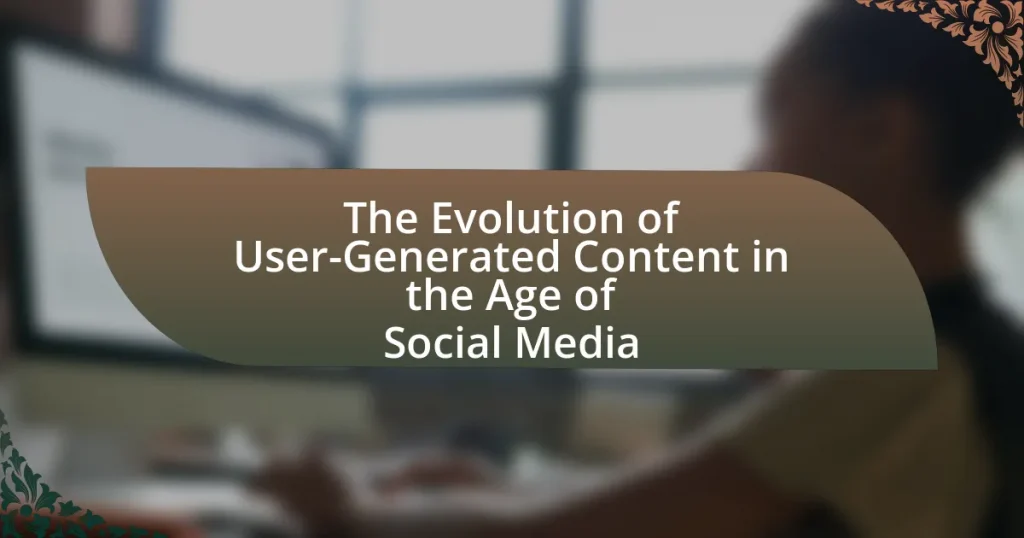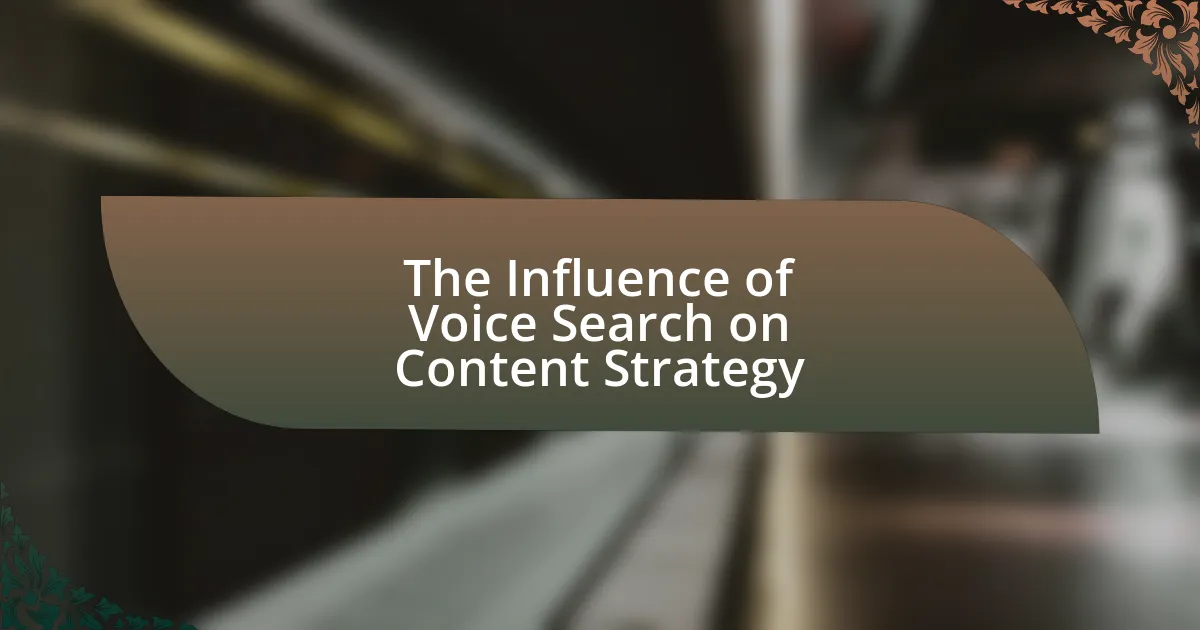User-Generated Content (UGC) has transformed significantly in the age of social media, encompassing various forms of content created by individuals rather than brands. This article explores the evolution of UGC, highlighting its characteristics, importance, and impact on consumer behavior, with statistics indicating that 79% of consumers find UGC influential in their purchasing decisions. It examines the historical milestones that shaped UGC, the role of early social media platforms, and current trends such as authenticity and short-form video content. Additionally, the article addresses the challenges brands face with UGC, including quality control and legal considerations, while providing best practices for effectively leveraging UGC to enhance brand engagement and trust.

What is User-Generated Content in the Age of Social Media?
User-Generated Content (UGC) in the age of social media refers to any form of content, such as text, images, videos, and reviews, that is created and shared by individuals rather than brands or organizations. This phenomenon has gained significant traction due to the rise of platforms like Instagram, TikTok, and YouTube, where users actively engage in content creation and sharing. According to a 2021 report by Statista, 79% of people say user-generated content highly impacts their purchasing decisions, highlighting its influence on consumer behavior. UGC fosters community engagement, enhances brand authenticity, and serves as a powerful marketing tool, as it often resonates more with audiences than traditional advertising.
How has the definition of User-Generated Content evolved over time?
User-Generated Content (UGC) has evolved from simple contributions on early internet forums to a multifaceted concept encompassing various forms of media created by users across social platforms. Initially, UGC referred primarily to text-based contributions, such as comments and forum posts, but with the rise of social media, it expanded to include images, videos, and live streams, reflecting the diverse ways users engage with content. For instance, platforms like YouTube and Instagram have transformed UGC into a significant driver of marketing and brand engagement, with statistics showing that 79% of people say user-generated content highly impacts their purchasing decisions. This evolution highlights the increasing importance of authenticity and community in content creation, as brands leverage UGC to foster trust and connection with their audiences.
What are the key characteristics of User-Generated Content today?
User-Generated Content (UGC) today is characterized by its authenticity, engagement, and diversity. Authenticity is crucial as users seek genuine experiences and opinions, leading to higher trust levels; for instance, 79% of consumers say user-generated content highly impacts their purchasing decisions. Engagement is another key characteristic, as UGC fosters community interaction and participation, with platforms like Instagram and TikTok encouraging users to create and share content actively. Lastly, diversity in UGC reflects a wide range of perspectives and creativity, showcasing various voices and styles, which enhances relatability and connection among users.
How does User-Generated Content differ from traditional content?
User-Generated Content (UGC) differs from traditional content primarily in its origin; UGC is created by consumers or users rather than brands or professional creators. This distinction highlights that UGC often reflects authentic experiences and opinions, fostering a sense of community and engagement among users. In contrast, traditional content is typically produced by companies with a focus on marketing and brand messaging, which can lead to a more polished but less relatable presentation. Research indicates that 79% of people say user-generated content highly impacts their purchasing decisions, demonstrating its effectiveness compared to traditional advertising methods.
Why is User-Generated Content important in social media?
User-Generated Content (UGC) is important in social media because it enhances engagement and builds trust among users. UGC allows brands to leverage authentic voices and experiences from their audience, which can lead to increased brand loyalty and community building. According to a study by Nielsen, 92% of consumers trust organic, user-generated content more than traditional advertising, highlighting its effectiveness in influencing purchasing decisions. This trust is crucial in a digital landscape where consumers seek genuine interactions and relatable content.
What role does User-Generated Content play in user engagement?
User-Generated Content (UGC) significantly enhances user engagement by fostering a sense of community and authenticity. UGC encourages users to participate actively, as they feel their contributions are valued, leading to increased interaction with the brand or platform. According to a study by Nielsen, 92% of consumers trust organic, user-generated content more than traditional advertising, indicating that UGC can drive higher engagement rates. Furthermore, platforms that incorporate UGC often see longer session durations and increased sharing, as users are more likely to engage with content that reflects their own experiences and opinions.
How does User-Generated Content influence brand perception?
User-Generated Content (UGC) significantly influences brand perception by enhancing authenticity and trust among consumers. When potential customers encounter UGC, such as reviews, testimonials, or social media posts, they perceive the brand as more relatable and credible compared to traditional advertising. A study by Nielsen found that 92% of consumers trust organic, user-generated content more than traditional advertising, indicating that UGC can lead to increased brand loyalty and positive brand associations. Furthermore, brands that actively engage with UGC often see improved customer relationships and higher engagement rates, reinforcing the notion that UGC plays a crucial role in shaping how consumers view and interact with brands.

What are the historical milestones in the evolution of User-Generated Content?
User-Generated Content (UGC) has evolved through several historical milestones that have shaped its current landscape. In 1999, the term “User-Generated Content” was coined by journalist and author, Tom Coates, marking the formal recognition of content created by users rather than traditional media outlets. The launch of platforms like Blogger in 1999 and YouTube in 2005 enabled individuals to publish their own content easily, significantly increasing the volume and diversity of UGC. In 2006, the term “Web 2.0” emerged, emphasizing user participation and collaboration, which further propelled the growth of UGC across social media platforms. The rise of Facebook in 2004 and Twitter in 2006 allowed users to share their thoughts and experiences in real-time, fostering a culture of instant content creation. By 2010, the popularity of mobile devices and apps like Instagram transformed how users generated and consumed content, leading to a surge in visual UGC. These milestones collectively illustrate the trajectory of UGC from niche platforms to mainstream social media, fundamentally altering how content is created and shared online.
How did early social media platforms shape User-Generated Content?
Early social media platforms significantly shaped User-Generated Content (UGC) by providing accessible tools for users to create, share, and engage with content. Platforms like MySpace and Facebook, launched in the early 2000s, enabled users to publish personal profiles, share photos, and post updates, fostering a culture of participation and creativity. This democratization of content creation led to an explosion of diverse voices and perspectives online, as evidenced by the rapid growth of user-generated blogs and videos on platforms like YouTube, which launched in 2005. The ease of sharing and interacting with content on these platforms encouraged users to contribute actively, fundamentally altering the landscape of media consumption and production.
What were the first examples of User-Generated Content on social media?
The first examples of User-Generated Content (UGC) on social media include early platforms like Six Degrees, launched in 1997, which allowed users to create profiles and connect with friends, and LiveJournal, established in 1999, where users could publish personal blogs and share their thoughts. These platforms marked the beginning of UGC by enabling individuals to contribute their own content and interact with others online, laying the groundwork for the social media landscape we know today.
How did the rise of blogs and forums contribute to User-Generated Content?
The rise of blogs and forums significantly contributed to User-Generated Content by providing platforms for individuals to share their thoughts, experiences, and expertise. These platforms democratized content creation, allowing anyone with internet access to publish their ideas and engage with a wider audience. For instance, the launch of platforms like Blogger in 1999 and forums such as Reddit in 2005 enabled users to create and disseminate content without the need for traditional media gatekeepers. This shift led to an explosion of diverse voices and perspectives, fostering a culture where user contributions became integral to online discourse and information sharing. As a result, blogs and forums not only increased the volume of content available online but also encouraged community interaction and collaboration, further solidifying the role of User-Generated Content in the digital landscape.
What technological advancements have impacted User-Generated Content?
Technological advancements such as smartphones, high-speed internet, and social media platforms have significantly impacted User-Generated Content (UGC). Smartphones enable users to create and share content easily, with built-in cameras and editing tools facilitating instant uploads. High-speed internet allows for seamless sharing and streaming of multimedia content, increasing engagement and reach. Social media platforms like Instagram, TikTok, and YouTube provide dedicated spaces for UGC, offering features that promote virality and community interaction. According to a report by Statista, as of 2021, over 4.2 billion people worldwide were using social media, highlighting the vast audience for UGC and its growing importance in digital communication.
How have mobile devices changed the way users create content?
Mobile devices have significantly transformed the way users create content by enabling instant access to powerful tools for content generation and sharing. With smartphones equipped with high-quality cameras, editing software, and social media applications, users can produce and disseminate content in real-time, leading to a surge in user-generated content. According to a report by Statista, as of 2021, over 90% of social media users accessed platforms via mobile devices, highlighting the shift towards mobile-centric content creation. This accessibility has democratized content creation, allowing individuals to share their perspectives and experiences widely, thus reshaping the landscape of digital communication and engagement.
What role do algorithms play in the visibility of User-Generated Content?
Algorithms significantly influence the visibility of User-Generated Content (UGC) by determining which content is prioritized and shown to users. These algorithms analyze various factors, such as user engagement, relevance, and recency, to curate personalized feeds that enhance user experience. For instance, platforms like Facebook and Instagram utilize machine learning algorithms to assess user interactions, ensuring that content likely to generate engagement appears more prominently. This prioritization can lead to increased exposure for certain UGC, impacting its reach and effectiveness. Studies indicate that content with higher engagement rates, such as likes and shares, is favored by algorithms, thereby amplifying its visibility within social media ecosystems.

What are the current trends in User-Generated Content on social media?
Current trends in User-Generated Content (UGC) on social media include increased authenticity, the rise of short-form video content, and a focus on community engagement. Authenticity is prioritized as users seek genuine connections, leading brands to leverage real customer experiences in their marketing strategies. The popularity of platforms like TikTok has driven the growth of short-form videos, with 68% of marketers planning to increase their investment in this format. Additionally, community-driven content is gaining traction, with brands encouraging user participation through challenges and collaborations, fostering a sense of belonging among users. These trends reflect a shift towards more interactive and relatable content in the social media landscape.
How are influencers shaping User-Generated Content today?
Influencers are significantly shaping User-Generated Content (UGC) today by driving engagement and setting trends within social media platforms. Their ability to curate content that resonates with their followers encourages users to create and share their own content, often inspired by the influencers’ styles, themes, or challenges. For instance, a study by the Digital Marketing Institute found that 70% of millennials are influenced by the recommendations of their peers and social media influencers, leading to increased participation in UGC campaigns. This dynamic fosters a community-driven environment where users feel empowered to contribute, thus amplifying the reach and impact of UGC in marketing strategies.
What is the impact of micro-influencers on User-Generated Content?
Micro-influencers significantly enhance User-Generated Content (UGC) by fostering authentic engagement and trust among their followers. Their smaller, niche audiences often lead to higher engagement rates, with studies showing that micro-influencers can achieve engagement rates of 3.5% to 7%, compared to 1% for larger influencers. This increased interaction encourages followers to create and share their own content related to the brands promoted by micro-influencers, thereby amplifying UGC. Additionally, micro-influencers often have a more personal connection with their audience, which drives followers to participate in UGC campaigns, resulting in content that feels more relatable and genuine.
How do brands collaborate with influencers to enhance User-Generated Content?
Brands collaborate with influencers to enhance User-Generated Content (UGC) by leveraging the influencers’ reach and authenticity to encourage their followers to create content related to the brand. This collaboration often involves influencers sharing branded content, which motivates their audience to engage with the brand and produce their own content, such as reviews, photos, or videos featuring the brand’s products. For instance, a study by the Digital Marketing Institute found that 79% of consumers say user-generated content highly impacts their purchasing decisions, demonstrating the effectiveness of influencer partnerships in driving UGC.
What types of User-Generated Content are most popular on social media?
The most popular types of User-Generated Content (UGC) on social media include images, videos, reviews, and comments. Images, particularly those shared on platforms like Instagram, account for a significant portion of engagement, with studies showing that posts with images receive 650% higher engagement than text-only posts. Videos, especially short-form content on platforms like TikTok and Instagram Reels, have surged in popularity, with users increasingly favoring dynamic visual storytelling. Reviews and testimonials, particularly on platforms like Yelp and TripAdvisor, influence consumer decisions and are widely shared across social media. Comments and discussions on posts foster community engagement and interaction, making them a vital component of UGC.
What are the differences between visual, textual, and video User-Generated Content?
Visual, textual, and video User-Generated Content (UGC) differ primarily in their format and engagement potential. Visual UGC, such as images and infographics, captures attention quickly and is often shared for its aesthetic appeal, leading to higher engagement rates on platforms like Instagram. Textual UGC, including blog posts and comments, allows for in-depth expression and discussion, fostering community interaction and providing detailed information. Video UGC combines both visual and auditory elements, offering dynamic storytelling and higher retention rates, making it particularly effective on platforms like YouTube and TikTok. Each format serves distinct purposes in communication and audience engagement, reflecting the diverse ways users interact with content in the digital landscape.
How do different platforms prioritize various types of User-Generated Content?
Different platforms prioritize various types of User-Generated Content (UGC) based on their algorithms, user engagement metrics, and content relevance. For instance, Instagram emphasizes visually appealing content, prioritizing images and videos that garner high engagement rates, such as likes and comments, which are critical for visibility in users’ feeds. In contrast, platforms like Reddit prioritize content based on community votes and discussions, where upvoted posts gain prominence, reflecting user interests and preferences. Additionally, TikTok’s algorithm favors short, engaging videos that retain viewer attention, promoting content that encourages interaction and shares. These prioritization strategies are supported by data showing that platforms with higher engagement rates tend to promote content that aligns with user behavior and preferences, thereby enhancing user experience and retention.
What challenges do brands face with User-Generated Content?
Brands face several challenges with User-Generated Content (UGC), including quality control, brand reputation management, and legal issues. Quality control is a significant concern as UGC can vary widely in quality, potentially harming a brand’s image if low-quality content is associated with it. Additionally, managing brand reputation becomes complex when UGC includes negative feedback or controversial opinions, which can spread rapidly on social media platforms. Legal issues also arise, particularly concerning copyright and intellectual property rights, as brands must navigate the complexities of using content created by consumers without infringing on their rights. These challenges necessitate careful strategies to effectively leverage UGC while mitigating risks.
How can brands manage negative User-Generated Content effectively?
Brands can manage negative User-Generated Content effectively by implementing a proactive response strategy that includes monitoring, engagement, and resolution. Monitoring tools allow brands to track mentions and sentiments across social media platforms, enabling them to identify negative content quickly. Engaging with users who post negative content in a respectful and empathetic manner can help de-escalate situations and demonstrate that the brand values customer feedback. Additionally, providing solutions or compensations can turn a negative experience into a positive one, fostering customer loyalty. Research indicates that 70% of consumers are more likely to recommend a brand that responds to negative feedback, highlighting the importance of effective management strategies.
What legal considerations should brands be aware of regarding User-Generated Content?
Brands should be aware that User-Generated Content (UGC) can raise legal issues related to copyright, trademark, and privacy rights. When brands use UGC, they must ensure they have the necessary permissions from the content creators to avoid copyright infringement, as creators hold the rights to their original works. Additionally, brands should be cautious of potential trademark violations if UGC includes protected brand elements without authorization. Privacy concerns also arise, particularly if UGC features identifiable individuals; brands must obtain consent to use such content to comply with privacy laws. These legal considerations are crucial for brands to mitigate risks and ensure compliance with intellectual property and privacy regulations.
What best practices can brands follow to leverage User-Generated Content?
Brands can effectively leverage User-Generated Content (UGC) by encouraging customer participation, showcasing authentic testimonials, and integrating UGC into marketing strategies. Encouraging customers to share their experiences through contests or hashtags increases engagement and creates a community around the brand. Showcasing authentic testimonials builds trust, as 79% of consumers say user-generated content highly impacts their purchasing decisions. Integrating UGC into marketing strategies, such as featuring customer photos in advertisements or on social media, enhances relatability and can lead to higher conversion rates.
How can brands encourage more User-Generated Content from their audience?
Brands can encourage more User-Generated Content (UGC) from their audience by implementing interactive campaigns that incentivize participation. For instance, brands can host contests or challenges that reward users for creating and sharing content related to their products, which has been shown to increase engagement. According to a study by the Content Marketing Institute, 79% of people say user-generated content highly impacts their purchasing decisions, indicating that UGC not only fosters community but also drives sales. Additionally, brands can leverage social media platforms to create hashtags that users can easily adopt, making it simpler for audiences to share their experiences and connect with the brand.
What strategies can brands use to showcase User-Generated Content effectively?
Brands can effectively showcase User-Generated Content (UGC) by integrating it into their marketing campaigns across multiple platforms. Utilizing social media channels, brands can create dedicated hashtags to encourage customers to share their experiences, which fosters community engagement and increases visibility. For instance, a study by Stackla found that 79% of people say user-generated content highly impacts their purchasing decisions, demonstrating the effectiveness of UGC in influencing consumer behavior. Additionally, brands can feature UGC on their websites and in email marketing, which not only enhances authenticity but also builds trust with potential customers. By curating and displaying UGC, brands can leverage the creativity and loyalty of their customers, ultimately driving sales and brand loyalty.




